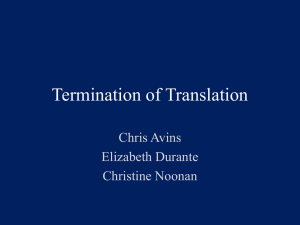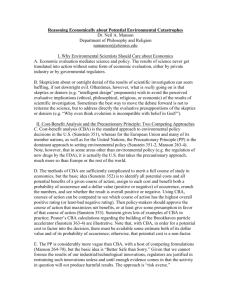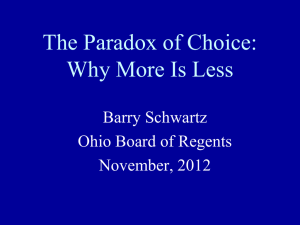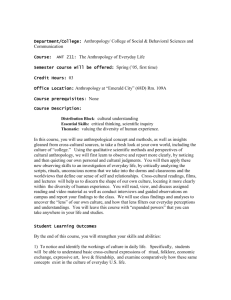Six Degrees of Cass Sunstein
advertisement
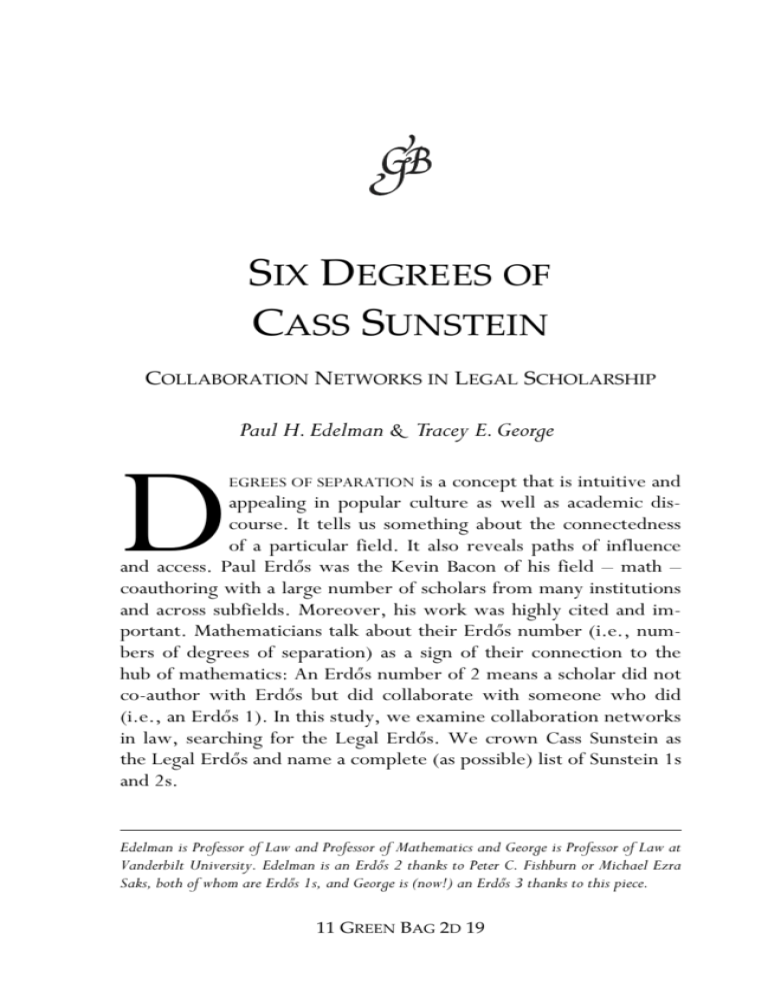
SIX DEGREES OF CASS SUNSTEIN COLLABORATION NETWORKS IN LEGAL SCHOLARSHIP D Paul H. Edelman & Tracey E. George† is a concept that is intuitive and appealing in popular culture as well as academic discourse. It tells us something about the connectedness of a particular field. It also reveals paths of influence and access. Paul Erdős was the Kevin Bacon of his field – math – coauthoring with a large number of scholars from many institutions and across subfields. Moreover, his work was highly cited and important. Mathematicians talk about their Erdős number (i.e., numbers of degrees of separation) as a sign of their connection to the hub of mathematics: An Erdős number of 2 means a scholar did not co-author with Erdős but did collaborate with someone who did (i.e., an Erdős 1). In this study, we examine collaboration networks in law, searching for the Legal Erdős. We crown Cass Sunstein as the Legal Erdős and name a complete (as possible) list of Sunstein 1s and 2s. † EGREES OF SEPARATION Edelman is Professor of Law and Professor of Mathematics and George is Professor of Law at Vanderbilt University. Edelman is an Erdős 2 thanks to Peter C. Fishburn or Michael Ezra Saks, both of whom are Erdős 1s, and George is (now!) an Erdős 3 thanks to this piece. 11 GREEN BAG 2D 19 Paul H. Edelman & Tracey E. George Stanley Milgram coined the phrase “degrees of separation” to describe the small world experience – discovering in a new place that a stranger shares an acquaintance.1 Milgram hypothesized that any person could be connected to another person through a short chain of acquaintances, or intermediaries. John Guare popularized the phrase in his play, Six Degrees of Separation,2 but it is perhaps best known now for the popular game, Six Degrees of Kevin Bacon.3 Players must connect a named actor to Bacon by looking first at the actor’s co-stars, then to the co-stars’ co-stars, and so on until Bacon is linked to the actor. The minimum number of co-stars between the actor and Bacon is the number of degrees of separation between them. Nearly 900,000 actors can be linked to Bacon, and, on average, it takes only three co-stars to do so. If actors collaborate by co-starring, academics collaborate by coauthoring. Most scholarship, of course, is collaborative in the broader sense that it builds on the works of other scholars (“derivative collaboration”) and reflects feedback from colleagues (“partici1 2 3 Stanley Milgram, The Small World Problem, 1 PSYCH. TODAY 61 (1967). Milgram offered the example of “Fred Jones of Peoria, [who, while] sitting in a sidewalk café in Tunisia … falls into a conversation [with] an Englishman who, it turns out, spent several months in Detroit.” While there, the Englishman met a grocery store manager who is an old friend of Jones, prompting him to exclaim, “Good lord, it’s a small world, isn’t it?” “I read somewhere that everybody on this planet is separated by only six other people. … It’s a profound thought. … Six degrees of separation between me and everyone else on this planet. But to find the right six people.” John Guare, SIX DEGREES OF SEPARATION: A PLAY 81 (1990) (Ouisa speaking to the audience). The Oracle of Bacon at Virginia, created and maintained by the Department of Computer Science at the University of Virginia, allows you to calculate the degrees of separation between any two actors. http://oracleofbacon.org/. For example, Queen Latifah is a Bacon 1 because she co-starred in Beauty Shop with Bacon. Dame Helen Mirren, who earned an Oscar for portraying Queen Elizabeth II, has a Bacon number of 2: She co-starred in Losing Chase with Kyra Segwick who co-starred in Loverboy, among other movies, with Kevin Bacon. (Mirren also co-starred in The Passion of Ayn Rand with Don McKellar who was in Where the Truth Lies with Kevin Bacon.) Bacon’s direction of Mirren in Losing Chase does not give Mirren a Bacon 1 because the number is based on individuals working together as actors. 20 11 GREEN BAG 2D Six Degrees of Cass Sunstein patory collaboration”).4 Collaboration that leads to co-authorship, however, is the most formal and arguably the most significant evidence of an intellectual partnership. Numerous studies have examined the degrees separating scholars based on co-authorship.5 But no one has attempted to construct a “collaboration network” for the field of law. In order to do this, we first have to identify the likely center. We are not attempting to name the most important or influential legal scholar, although influence will be relevant. Instead we are asking who is likely to connect the most people in the smallest number of steps. That is, who is our Kevin Bacon? Or, more appropriately, who is our Paul Erdős? Erdős, pronounced “air-dish,” was a brilliant and legendary mathematician who wrote more than 1,500 mathematical research papers – “many of them monumental, and all of them substantial” – on a wide array of topics.6 A mathematical nomad, Erdős lacked both a job and a home. He instead traveled incessantly, stopping just long enough to solve problems with scholars in whose homes he often stayed.7 He literally gave his life over to his work in mathematics. Mathematicians, beginning in the Sixties, began to calculate a person’s “Erdős number” as a means of measuring the person’s connection to the field and also as a measure of the level of collaboration in the discipline.8 Erdős’s own Erdős number is 0. Erdős’s 4 5 6 7 8 See Tracey E. George & Chris Guthrie, Joining Forces: The Role of Collaboration in the Development of Legal Thought, 52 J. LEGAL EDUC. 559, 561 (2002) (introducing these terms). See, e.g., James Moody, The Structure of a Social Science Collaboration Network: Disciplinary Cohesion from 1963 to 1999, 69 AM. SOC. REV. 213 (2004); M.E.J. Newman, The Structure of Scientific Collaboration Networks, 98 PROC. NAT’L ACAD. SCI. 404 (2001). See Paul Hoffman, THE MAN WHO LOVED ONLY NUMBERS: THE STORY OF PAUL ERDŐS AND THE SEARCH FOR MATHEMATICAL TRUTH 6 (1998). See Gina Kolata, Paul Erdős, a Math Wayfarer at Field’s Pinnacle, Dies at 83, N.Y. TIMES, Sept. 24, 1996 (Obituary). See also N IS A NUMBER: A PORTRAIT OF PAUL ERDŐS (Moviefish 1993) (Documentary). Casper Goffman, And What is Your Erdős Number?, 76 AM. MATH. MONTHLY 791 (1969). AUTUMN 2007 21 Paul H. Edelman & Tracey E. George co-authors have an Erdős number of 1. People who have written a joint paper with an Erdős 1 have Erdős number 2, and so on. If there is no chain of co-authorships connecting someone with Erdős, then that person’s Erdős number is said to be infinite. Nearly 500 scholars have an Erdős number of 1, and more than 8,000 can claim Erdős 2. In this essay, we seek to identify the legal Erdős and to examine the legal academic network by looking at the number of scholars who can claim to be within two degrees of this central legal academic. We begin our paper with an explanation of network theory. Network theory offers a more theoretically sophisticated exposition on the small world or degrees of separation concept. We then turn to law schools in search of the one scholar who likely connects the most legal scholars. We argue below that Cass Sunstein is probably the best center for the legal academy. Lacking a legal scholarship database suitable for computer algorithms, we selected Sunstein based on a series of characteristics that distinguish a central hub in a network. We then present a list of Sunstein 1s and 2s. What is your Sunstein number? I STUDYING THE SMALL WORLD: NETWORK THEORY I n our study of collaboration in legal academia, we will be employing terminology and techniques from social network theory, also known as SNT. Social network theory has its origins in the work of sociologists and anthropologists early in the twentieth century.9 While sociologists and anthropologists contributed initially to 9 John Scott, SOCIAL NETWORK ANALYSIS: A HANDBOOK 7 (2d ed. 2000) (explaining that modern SNT can be traced to “three main traditions: the sociometric analysts, who worked on small groups and produced many technical advances with the methods of graph theory; the Harvard researchers of the 1930s, who explored patterns of interpersonal relations and the formation of ‘cliques’; and the Manchester anthropologists, who built on both of these strands to investigate the structure of ‘community’ relations in tribal and village societies” and that “[t]hese traditions were eventually brought together in the 1960s and 1970s, again at Harvard, when contemporary social network analysis was forged”). 22 11 GREEN BAG 2D Six Degrees of Cass Sunstein its development, much of the recent work on social networks has moved to applied mathematics, physics, and computer science.10 There has been a trend throughout science to model natural phenomena by networks.11 There is little doubt that the rise of the internet, and attempts to model its growth and attributes, contributed to this development. The increase in size and the dynamic nature of the growth of the networks under consideration has led to a change in the methods used to study them, as well. Contemporary analyses apply methods from statistical physics and probability. The study of collaboration networks in particular has been spurred by a number of considerations. One is the inherent interest12 of academics in studies of their own behavior.13 Another is that, with contemporary databases and high-speed computing, one has (relatively) easy access to a large array of quite complete data and the computational power necessary to model it. Lastly, there is a natural metric of time (publication date or posting date) that allows for the study of the dynamic behavior of the network. Before proceeding further, it will be helpful to define some terminology. The mathematical formulation of a collaborative network is drawn from the discipline of graph theory.14 A graph is defined by specifying a set of vertices or nodes (the discipline lacks a standard terminology) and a set of edges or links, which are certain pairs of vertices. In our application, the vertices will be the set of all law professors and the edges will be pairs of law professors who have co-authored a published paper or book (perhaps just between them, but possibly with other authors as well). 10 For a survey on these more technical approaches to social networks, see M.E.J. Newman, The Structure and Function of Complex Networks, 45 SIAM REV. 167 (2003). 11 See the 429 citations in the previously cited article. Id. at 241. 12 One might even say the navel-gazing appeal. 13 “[O]ur subject matter will be of interest to physicists for another reason: it’s about them.” M.E.J. Newman, Scientific Collaboration Networks: I. Network Construction and Fundamental Results, 64 PHYS. REV. E, 016131 (2001). 14 See Douglas West, INTRODUCTION TO GRAPH THEORY (2d ed. 2000). AUTUMN 2007 23 Paul H. Edelman & Tracey E. George It is common to depict a graph with a drawing in which vertices are shown as points and edges are line segments connecting the relevant vertices. To illustrate, suppose there are law professors Edelman, Farber, George and Sherry. In addition, suppose that Edelman and Sherry have co-authored a paper,15 Farber and Sherry have co-authored a paper,16 Edelman has not co-authored with Farber, and George has co-authored with none of the others. This graph is depicted in Figure 1. Note that, after this article is published, a new edge between Edelman and George should be added. The number of edges incident on a vertex is called the degree of the vertex. In Figure 1, Farber and Edelman each have degree 1, Sherry has degree 2 and George has degree 0. In collaborative networks, the degree corresponds to the number of different coauthors a particular person has had. One of the central problems in the study of collaborative networks is to describe the distribution of degrees in a collaborative network. What is of particular interest to network theorists is that earlier models of networks exhibited degree distributions that were exponentially decaying, i.e., the likelihood of a vertex of degree k being 15 Paul H. Edelman & Suzanna Sherry, Pick a Number Any Number: State Representation in Congress after the 2000 Census, 90 CAL. L. REV. 211 (2002). 16 Daniel A. Farber & Suzanna Sherry, DESPERATELY SEEKING CERTAINTY: THE MISGUIDED QUEST FOR CONSTITUTIONAL FOUNDATIONS (2002). 24 11 GREEN BAG 2D Six Degrees of Cass Sunstein present decreases exponentially as a function of k.17 It has long been observed, however, that in collaboration networks the degree distribution followed a power law and thus had a “fat” or heavy tail.18 The implication of this difference is that in collaborative networks one expects to find many more vertices of large degree, i.e., academics with a large number of co-authors, than one would see in an ordinary network. Barabási and his colleagues analyzed a very attractive model of collaborative networks that closely conforms to actual networks.19 The key idea is that of preferential attachment: “A much used assumption is that in [collaborative networks] nodes link with higher probability to those nodes that already have a larger number of links, a phenomena [sic] labeled as preferential attachment.”20 The principle of preferential attachment makes concrete the intuition that authors with a large number of collaborators are more likely to join new collaborations than those who have had fewer collaborators. Preferential attachment plays two different roles in the development of a collaboration network. The first is in the addition of new vertices to the network. The model assumes that new vertices (authors) are added to the network at a constant rate, and that the likelihood that a new vertex will have an edge to an old vertex is proportional to the degree of the old vertex. Barabási and his colleagues describe it this way: “For a new author, that appears for the first time on a publication, preferential attachment has a simple 17 See, e.g., Béla Bollobás, RANDOM GRAPHS (1985). A fat-tailed distribution has a large kurtosis, that is a large amount of the variance in the distribution is attributable to observations at the extremes of the distribution. By contrast, over 99% of the variance in the familiar bell-shaped normal distribution is within three deviations of the mean. 19 A.L. Barabási, H. Jeong, Z. Néda, E. Ravasz, A. Schubert & T. Vicsek, Evolution of the Social Network of Scientific Collaborations, 311 PHYSICA A 590 (2002). 20 Id. at 595. As noted earlier, text accompanying note 14, node is synonymous with vertex. The original refers to “scale free networks” rather than “collaborative networks.” Scale-free networks are a larger class of networks of which collaborative networks are an example. 18 AUTUMN 2007 25 Paul H. Edelman & Tracey E. George meaning: it is more likely that the first paper will be co-authored with somebody that already has a large number of co-authors [links] that [sic] with somebody less connected.”21 The second role preferential attachment plays is in the addition of new edges between vertices that are already in the network, i.e., new collaborations between authors who have already published. In this case, preferential attachment means that new collaborations are more likely between authors each of whom already collaborated frequently. To be more precise, the model assumes that the likelihood of a new collaboration between two authors is a function of the product of the degrees of those two authors. Thus, the likelihood of a new collaboration between two authors, each of degree 2 is larger than the likelihood of a new collaboration between one author of degree 3 and another of degree 1.22 We have thus formulated the dynamical rules that govern our evolving network model, capturing the basic mechanism governing the evolution of the co-authorship network: 1. Nodes join the network at a constant rate. 2. Incoming nodes link to the already present nodes following preferential attachment. 3. Nodes already present in the network form new internal links following preferential attachment. 4. We neglect the aging of nodes, and assume that all nodes and links present in the system are active, able to initiate and receive new links.23 The power of the formal model is quite extraordinary, given its rather elementary assumptions. For example, it follows from the analysis that the tail of the distribution of degrees in the long run is a power law with exponent 2, but in shorter time frames it looks more like a power law with exponent 3. “Thus, the model predicts that the degree distribution of the collaboration network displays a 21 Id. at 596 (equation (7)) Since 2 × 2 = 4 > 3 ×1 = 3. See id. at 596 (equation (6)). 23 Id. 22 26 11 GREEN BAG 2D Six Degrees of Cass Sunstein crossover between two scaling regimes,”24 a prediction which is borne out by the data. The very powerful techniques that we have just discussed rely on having considerable information about the collaboration network. There is, however, another tradition of investigating collaboration networks that focuses on much more local information. The very first of the collaboration networks to be investigated was the collaboration of mathematicians.25 The focus of the early studies was the one vertex of conspicuously large degree, Paul Erdős. It is this strategy that we will employ in this paper. II I SEARCHING FOR THE LEGAL ERDŐS f we had a database of all authors organized by article and collaborator(s), then we could construct a computer algorithm that would calculate the author who approximates a “center” of the legal scholarship network, i.e., the person for whom the average degree of separation is the lowest. While searchable databases of articles, such as Hein Online and Westlaw, exist, none are structured in a manner that allows for this analysis.26 Thus, we had to take a different tack to approximate this process. We sought to identify a legal scholar with characteristics that make it more likely that she or he is the central hub in the legal collaboration network: a legal Erdős.27 Erdős numbers offer a way to 24 Id. at 597. The oldest published reference we know is Goffman in 1969. See Goffman, supra note 8. Goffman refers to having discussed this matter “several years ago;” thus, awareness of the network evidently predates this reference by some time. Id. 26 The LSAC has funded a large-scale longitudinal database of legal scholarship. But, it won’t be available for a long time. When it is, we’ll be able to test our conclusion and create a more complete account of the legal collaboration network. For more information, see Some Interesting Factoids on Legal Scholarship, EMPIRICAL LEGAL STUDIES BLOG, June 27, 2007, www.elsblog.org/the_empirical_legal_ studi/2007/06/some-interest-1.html. 27 We are seeking to identify a law professor who has Erdős’s collaboration network characteristics rather than his eccentric personal ones. 25 AUTUMN 2007 27 Paul H. Edelman & Tracey E. George measure someone’s connection to the mathematics collaboration network because Erdős published frequently and widely with scholars from many institutions and his work was influential. We are looking, then, for a scholar who: • actively collaborates with a range of scholars (lots of edges), • publishes often and across fields (dispersion of vertexes and edges across academy), • has achieved a high level of recognition (a nontrivial vertex), and • will continue to co-author into the foreseeable future (a nondecaying vertex). We were able to begin by using a database that George and Chris Guthrie created of prominent collaborators in law: Those whose coauthored work was frequently cited. 28 We do not claim, however, that the individual whom we identify is the most active collaborator in law. Rather, the person is the most Erdős-like collaborator. We believe this decision is valid for several reasons. First, the individual is recognized in part for her co-authored work. Such individuals seem strong candidates for the legal Erdős because they’ve demonstrated the ability to co-author successfully. And, positive feedback – the frequent citations to the co-authored work – increase the probability that the author will choose to collaborate in the future and that other scholars will wish to co-author with her. Highly cited co-authors’ collaborators likely include independently successful scholars. And those individuals likely collaborate frequently in a way consistent with the preferential attachment observation. Those collaborations, in turn, increase the number of edges that lead back to the selected center. Finally, the costs of identifying the most-collaborative scholar in law would be extraordinarily large: It would require determining the number of co- 28 See George & Guthrie, supra note 4. 28 11 GREEN BAG 2D Six Degrees of Cass Sunstein authors for each of the roughly 7,000 law professors.29 Thus, reality dictated narrowing the list. Numerous legal scholars are known for highly productive and influential collaborations. Richard Posner’s and William Landes’s partnership, for example, brought economic analysis to law.30 However, while they frequently worked together, neither Posner nor Landes co-authored with many others. Of the most cited legal collaborations, only a small number of the authors have written with more than a dozen different people. Two scholars stand out on this score: Yale law professor and economist Ian Ayres and University of Chicago law professor Cass Sunstein. As of January 2007, Ayres has published with 44 people (including his two children), and Sunstein with 58. Advantage: Sunstein. Ayres and Sunstein are remarkably productive. Ayres’s publication list includes nine books and more than 100 articles. But, while humbling, Ayres’s sizable body of work doesn’t match Sunstein’s (at least not yet). Sunstein defines prolific, publishing close to 500 works, and he undoubtedly will have reached or surpassed that number by the time you are reading this. His list of co-authored works also is long: That figure includes more than 80 works written with others. Advantage: Sunstein. It is self-evident that a legal Erdős must be a productive scholar, collaborating with many other scholars. But, the requirement of influence may require additional explanation. Mathematicians know their Erdős numbers because Erdős is an important figure; movie fans care about the Bacon number because everyone has seen a Kevin Bacon movie (or two). We believe that the legal scholar we select must be someone with real salience for the choice to resonate. Both Ayres and Sunstein are well-recognized and highly cited. In a 2003 study, Brian Leiter found that Cass Sunstein was the 29 See Association of American Law Schools, Statistical Report on Law School Faculty and Candidates for Law Faculty Positions, Tables 2005-2006, http://aals. org.cnchost.com/statistics/0506/0506_T1A_tit4.html (last visited Sept. 28, 2007). 30 See, e.g., William M. Landes & Richard A. Posner, THE ECONOMIC STRUCTURE OF TORT LAW (1987). AUTUMN 2007 29 Paul H. Edelman & Tracey E. George most-cited living legal scholar with an average of 335 citations per year in law teaching.31 (By comparison, Laurence Tribe, who generally authors alone, had a rate of 231 per year.) Ayres tied for 18th overall with 111 citations per year in law teaching. The legal thinker, as opposed to legal academic, who might have been the most cited if included – Judge Posner – works either alone or with one of a small number of potential collaborators. Advantage: Sunstein. Sunstein also writes in many areas. He is an expert in numerous fields – administrative law, constitutional law, environmental law, animal rights, law and economics, behavioral law and economics – and also has examined other issues including technology, gay rights, federal courts, employment law, family law, securities law, and so on. His research interests span the legal discipline so widely that his work is relevant to scholars in nearly every field. Ayres has written on numerous subjects as well, including gay rights, discrimination, corporate law, contracts, and antitrust. While Sunstein may have a covered more legal ground, Ayres has written more frequently on private law topics. Indeed, the choice of Sunstein likely will capture more public law scholars while the choice of Ayres will connect more private law scholars. Advantage: toss-up. The final issue is decay: Which scholar is likely to be the vertex of highest degree in five or ten years? Ayres and Sunstein each have been collaborating at an average rate of 2.2 co-authors per year in law teaching. Ayres is five years younger than Sunstein and so may well continue to collaborate after Sunstein has stopped. Nevertheless, Ayres will likely have considerable ground to make up – if we assume each scholar continues to co-author at the present rate and that Ayres gains ten co-authors after Sunstein stops writing, then Sunstein would still have slightly more co-authors than Ayres. Advantage: Sunstein. 31 See Brian Leiter’s Law School Rankings, Brian Leiter’s 50 Most Cited Faculty Per Year in Law Teaching, 2003-04, www.leiterrankings.com/faculty/2003faculty_impact _citesyear.shtml (last visited Sept. 28, 2007). For a more detailed explanation of his methodology, see Brian Leiter, Measuring the Academic Distinction of Law Faculties, 29 J. LEGAL STUD. 451 (2000). 30 11 GREEN BAG 2D Six Degrees of Cass Sunstein We would like to construct a network that connects as many scholars as possible and is as diverse as possible in terms of subject areas and institutions. Sunstein’s productivity, number of coauthors, and range of topics ultimately lead us to crown him the legal Erdős.32 III H COMPUTING SUNSTEIN NUMBERS aving selected Sunstein as the legal Erdős, we began by compiling a complete list of every published work by Sunstein and at least one co-author. Work here includes books, articles in academic periodicals, and articles in the popular press. A work is published if it is available in final full text form in either a printed source or on a digital publishing platform like SSRN. We needed a complete list, thus we searched every readily available source including Sunstein’s webpage and numerous searchable databases (Amazon.com, Hein Online, JSTOR, LexisNexis, InfoTrac, LegalTrac, Westlaw, library catalog, SSRN, and the like). The Sunstein collaboration network includes a substantial number of scholars from other fields as well as nonscholars, as seen in the list of 73 Sunstein 1s (Table 1). (The data are for publication dates through January 2007. Author information for Sunstein 1s and 2s reflects institutional affiliation in spring 2007, if available. If we were unable to locate the author, we printed the institution affiliation, if any, listed in the publication.) Nearly half of the authors are not law professors. This finding is consistent with anecdotal accounts of the willingness of law professors to work with faculty in other departments as well as practitioners, policymakers, and students. 32 In the spirit of full disclosure, we should report our own Sunstein numbers. Edelman is a Sunstein 4 through the chain Edelman → Suzanna Sherry → Thomas D. Rowe → Mark V. Tushnet → Sunstein. George is a Sunstein 3 through the chain George → Michael Solimine → Lawrence Lessig → Sunstein. It is probably also worth noting that Sunstein is an Erdős 4 through the chain Sunstein → W. Kip Viscusi → Donald A. Berry → Robert W. Chen → Erdős. AUTUMN 2007 31 Paul H. Edelman & Tracey E. George Table 1. All Sunstein 1 Authors Ackerman, Bruce Yale Law School Adler, Matthew D. Univ. of Pennsylvania Law School Amar, Akhil Reed Yale Law School Ashley, Kevin D. Univ. of Pittsburgh School of Law Balkin, Jack M. Yale Law School Barnett, Randy E. Georgetown Univ. Law Center Bell, Anthony Univ. of Chicago Dept. of Pediatrics Benartzi, Shlomo UCLA School of Management Bloch, Susan Low Georgetown Univ. Law Center Bobbitt, Philip Univ. of Texas Law School Branting, L. Karl BAE Systems, Inc. Breyer, Stephen G. U.S. Supreme Court Cortes, Ernesto Jr. Industrial Areas Foundation Dam, Kenneth Univ. of Chicago Law School Elliott, E. Donald Willkie Farr & Gallagher LLP Ellman, Lisa Michelle Mayer, Brown, Rowe & Maw LLP Epstein, Richard A. Univ. of Chicago Law School Fallon, Richard Harvard Law School Frank, Robert H. Cornell Univ. School of Management Goldsmith, Jack L. Harvard Law School Hahn, Robert W. AEI-Brookings Joint Center for Reg. Studies Hastie, Reid Univ. of Chicago School of Business Holmes, Stephen NYU School of Law Houston, Christopher E. Ropes & Gray LLP Hsiung, Wayne H. Northwestern Univ. School of Law Jolls, Christine M. Yale Law School Kahneman, Daniel J. Princeton Univ. School of Public and Int’l Affairs King, Robert E. South Orange County Community College District Kahn, Paul Yale Law School Karlan, Pamela S. Stanford Law School 32 11 GREEN BAG 2D Six Degrees of Cass Sunstein Table 1. All Sunstein 1 Authors Kuran, Timur USC Dept. of Economics Kurland, Philip Univ. of Chicago Law School (deceased) Laycock, Douglas Univ. of Texas Law School Meadow, William L. Univ. of Chicago School of Medicine Lessig, Lawrence Stanford Law School Margolis, Howard Univ. of Chicago School of Public Policy Meares, Tracey L. Yale Law School Meltzer, Bernard D. Univ. of Chicago Law School (deceased) Michelman, Frank I. Harvard Law School Miles, Thomas J. Univ. of Chicago Law School Miller, Ellen S. Sunlight Foundation Murphy, Kevin M. Univ. of Chicago School of Business Nussbaum, Martha Craven Univ. of Chicago Law School O’Neill, Catherine A. Seattle Univ. School of Law Payne, John W. Duke Univ. School of Business Perry, Michael J. Emory Law School Pildes, Richard H. NYU School of Law Posner, Eric A. Univ. of Chicago Law School Post, Robert Yale Law School Rapoport, Miles S. Demos Rosen, Sherwin Univ. of Chicago Dept. of Economics (deceased) Rubenfeld, Jed Yale Law School Ritov, Ilana Hebrew Univ. School of Education Schkade, David A. UCSD School of Management Seidman, Louis Michael Georgetown Univ. Law Center Spitzer, Matthew L. USC School of Law Stewart, Richard B. NYU School of Law Levinson, Sanford V. Univ. of Texas Law School AUTUMN 2007 Rowell, Kristen Arden Perkins Coie LLP Sawicki, Andres Judicial Law Clerk, USCA 2nd Circuit 33 Paul H. Edelman & Tracey E. George Table 1. All Sunstein 1 Authors Stone, Geoffrey R. Univ. of Chicago Law School Strauss, David A. Univ. of Chicago Law School Strauss, Peter L. Columbia Univ. Law School Sullivan, Kathleen M. Stanford Law School Thaler, Richard H. Univ. of Chicago School of Business Vermeule, Adrian Harvard Law School Tushnet, Mark V. Harvard Law School Utkus, Stephen P. Vanguard Center for Retirement Research Viscusi, W. Kip Vanderbilt Law School Waldron, Jeremy NYU School of Law Weisbach, David A. Univ. of Chicago Law School Ullmann-Margalit, Edna Hebrew Univ. School of Education Wellington, Harry New York Law School We next compiled a list of those co-authors’ co-authors (or Sunstein 2s) by following the same procedure for each of the Sunstein 1s. We found 837 authors who co-authored with at least one of the Sunstein 1s but did not co-author with Sunstein himself. The entire Sunstein 2 list is available on the Green Bag website. We can observe that the rate of expansion, as seen in Table 2, from the first degree to the second is as we would expect given prior collaboration network studies. However, the number of scholars within one degree is relatively small compared to other fields. This conclusion confirms studies finding a relatively low rate of collaboration in law. From 1970 through 1999, co-authored works comprised only 15 percent of law review articles.33 By contrast, two or more authors penned more than 60 percent of the articles published in leading social science journals during the same 33 See George & Guthrie, supra note 4, at 562 (reporting a 15 % rate for both elite law reviews and a random sample of other law reviews). 34 11 GREEN BAG 2D Six Degrees of Cass Sunstein period.34 As a consequence, collaboration network analysis in law necessarily will connect fewer scholars within the first two degrees. Table 2. Sunstein Number Distribution Sunstein Number No. of People 0 1 1 73 2 837 Sunstein’s co-authors, as predicted, are a highly collaborative bunch. The mean number of co-authors for a Sunstein 1 is 18. More than half of Sunstein 1’s can claim 15 or more co-authors, reflecting preferential attachment. And the majority of Sunstein 1’s have collaborated with another Sunstein 1. Only seven of the Sunstein 1’s can claim only Sunstein as a co-author. Nobel-Prize winning psychologist Daniel Kahneman has the largest number of co-authors with 85. Not surprisingly, all but three of the top 10 most collaborative Sunstein 1’s are social scientists working outside of law schools. But three law professors break the top-10: Vanderbilt law professor and economist W. Kip Viscusi (74 co-authors), University of Chicago law professor Richard Epstein (43), and Yale law professor Bruce Ackerman (39). Viscusi, with one more co-author than Sunstein, was not part of our original legal Erdős pageant because none of his co-authored work is among the most cited in the legal academy. Moreover, even if he had been in our pageant, he would have lost out to Sunstein. Viscusi obviously has one more edge than Sunstein, and he is comparably prolific (more than 20 books and 250 articles). However, while Viscusi is one of the most cited economists, he is not among the most cited legal scholars. Moreover, his scholarly range in law is 34 See id. at 565-66. AUTUMN 2007 35 Paul H. Edelman & Tracey E. George much narrower than either Ayres or Sunstein. Thus, in the end, he likely would not be an appropriate legal Erdős. L CONCLUSION egal academia is undergoing many changes, from the rise of interdisciplinary scholarship to the increase in “post-doctoral” opportunities in major law schools. Many of these changes can be seen as a move to a more academic model of law school and away from the professional school model. Yet one way in which legal academia has distinguished itself from many academic disciplines is in its reluctance to embrace collaboration in the production of knowledge. We think that this is beginning to change and this paper is one of the first attempts to quantify the level of collaboration in law. Unfortunately we are limited by the availability of data to do a fullblown analysis as has been done in other disciplines. Nevertheless, by following in the tradition of the original work on Erdős numbers we think we have made a step forward in seeing the direction of collaboration in law. In this paper we have identified Cass Sunstein as being the hub of the legal collaborative network. While both of us are admirers of his work, that is not the primary reason that we identified him as such. Rather it was the unique volume and breadth of his collaborative work which made him the inevitable choice. We guess that he is in the middle of the network and that he is likely to remain there for the foreseeable future. There is, perhaps, a more important role that we see Sunstein, as well as many of the other scholars that we mention, playing in legal academia. That is the role of the social entrepreneur in popularizing collaborative work in law. We think that his success and influence may well be significant in leading legal academia to more enthusiastically embrace collaboration. And, as one might guess from the nature of this project, we think that would be a good thing. 36 11 GREEN BAG 2D




